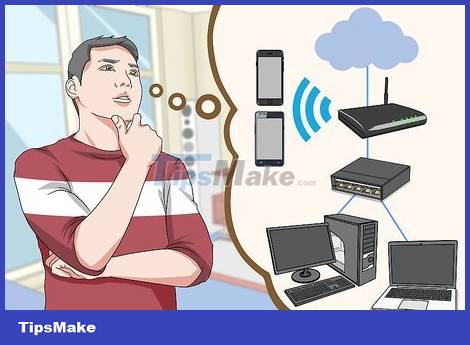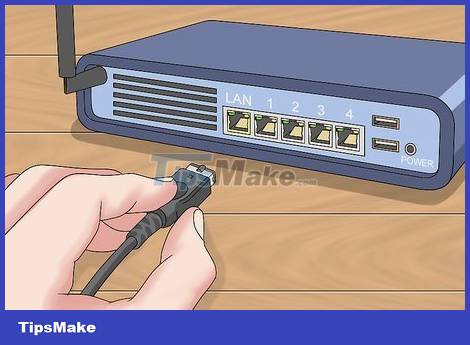How to Configure Computers on a Local Network
LAN settings

Determine the number of computers you want to connect to. The number of computers connected will determine the hardware network equipment you need to prepare.
If you're connecting fewer than 4 computers, you'll only need a single router or switch if you don't need an internet connection.
If you're connecting more than 4 machines, you'll need both a router and a switch, or just the switch if you don't need an internet connection.

Determine the network layout. If installing a fixed LAN, you should pay attention to the cable length. CAT5 Ethernet cables should not be longer than 80m. If you need to cover a wider distance, you should use a periodic switch or use CAT6 cable.
Each computer needs an Ethernet cable to connect to the LAN, an Ethernet cable to connect the router to the switch (if applicable).

Prepare hardware devices. To set up a LAN, you need a router and/or mesh network. This hardware device is the "center" of the LAN, all computers are connected here.
The simplest way to install a LAN when all computers can access the internet is to use a router, then install a switch if the router does not have enough connection ports. The router automatically assigns an IP address to each computer connected to it.
Switches are similar to routers, but do not automatically assign IP addresses. Switches usually have more connection ports than routers.

Connect the modem to the router's WAN port. This port may be named "INTERNET". This is the port that provides internet connection to computers on the LAN.
You can skip this step if you are installing a LAN without internet.
You don't need a router if you're just installing a regular LAN, but having a router will make the operation simpler. If you only use a network switch, you must manually assign an IP address to each computer after connecting.

Connect the switch to the LAN port on the router. If you use a switch to connect multiple computers, connect it to the LAN port on the router. You can use any port on the switch to make the connection. When connected, the router provides an IP address for each computer connected to the device.
Connect your computer

Find the Ethernet port on your computer. Usually, this port is located behind the desktop key, located behind or next to the laptop.
Ultra-thin laptops often do not have Ethernet ports. In that case, you'll need to use a USB Ethernet adapter or connect wirelessly to the router if possible.

Plug one end of the Ethernet cable into the computer. Remember to use an Ethernet cable (RJ45) and not a telephone cable (RJ11).

Plug the other end into the empty LAN port. You can plug into any LAN port on your router or switch, depending on your LAN settings.

Check the network (applies to routers only). If using a router, your job is done. Once computers connect to the LAN port, they are automatically assigned IP addresses and appear on the network. If you set up LAN to play games, you can start playing games right away!
If you use a switch and don't have a router, you must manually assign IP addresses to each computer.

Enable file and printer sharing. You cannot access resources on a computer on the network until file and printer sharing is enabled. You can select specific files, folders and hard drives to share with computers, or share access with printers.
Assign IP Address (No Router)

Right click on the network connection. You will see this icon in the System Tray. If you connect computers through a switch without using a router, you must manually assign IP addresses to each computer. This process will be done automatically if using a router.
The IP address is the mailing address. Each computer on the network needs a unique IP address so that information sent over the network reaches the correct destination.

Click Open Network and Sharing Center .

Click on the Ethernet link at the top of the window. You'll see a link next to "Connections."

Click Properties .

Click Internet Protocol Version 4 (TCP/IPv4) . Make sure you only highlight, do not uncheck, this item.

Click on Properties .

Click the Use the following IP address button .

Enter 192.168.1.50the IP address field.

Enter 255.255.0.0in the Subnet mask field.

Enter 192.168.0.0the Default gateway field.

Click the OK button . This is the operation to save settings on the computer. This computer is now configured on the network with a separate IP address.

Open the Internet Protocol Version 4 feature on the next computer. Follow the steps above to open the Internet Protocol Version 4 (TCP/IPv4) Properties window on the second computer.

Click the Use the following IP address button .

Enter 192.168.1.51the IP address field. Note that the last group of the number sequence increases by 1 unit.

Enter the same values as above in the Subnet mask and Default gateway fields . These values must be the same as the first computer (255.255.0.0 and 192.168.0.0).

Give each computer a separate IP address. Repeat the above steps for each additional computer, increasing the IP address by 1 unit (to 255). The "Subnet mask" and "Default gateway" fields on the machines must be the same on each computer.
You should read it
- Configure One-to-One NAT with TMG 2010
- How to Configure TP Link Router
- How to Configure Your PC to a Local Area Network
- Installing and configuring the 2004 ISA Server Firewall - Chapter 2 Installing Certificate Services
- How to Configure a Router
- Instructions for configuring IPv6 on Windows Server
- How to Set up a Computer Network
- How to set up and configure DDNS on Netgear router
May be interested
- How to reset Local Group Policy settings on Windows 10
 although on windows 10 users can find custom options in the settings and control panel applications. but when you have to make changes to the higher options, users can use local group policy editor. local group policy editor (gpedit.msc) is an important part of the operating system, integrated for a long time to configure settings across the entire computer or user accounts.
although on windows 10 users can find custom options in the settings and control panel applications. but when you have to make changes to the higher options, users can use local group policy editor. local group policy editor (gpedit.msc) is an important part of the operating system, integrated for a long time to configure settings across the entire computer or user accounts. - Access Windows Remote Desktop via Internet
 there are several solutions to access remote computers via internet like teamviewer, vnc. however, if you are running professional version of windows, remote desktop is installed in windows. before continuing, enable remote desktop on your computer and make sure you can access it from other computers on your local network.
there are several solutions to access remote computers via internet like teamviewer, vnc. however, if you are running professional version of windows, remote desktop is installed in windows. before continuing, enable remote desktop on your computer and make sure you can access it from other computers on your local network. - Share a folder on the local network for new users
 if you or someone else has never learned how to share a folder over a local network, this tutorial will show you how.
if you or someone else has never learned how to share a folder over a local network, this tutorial will show you how. - How to Configure TP Link Router
 a router (or router) is a device that connects multiple devices (such as computers and smartphones) to a network. with a newly purchased tp-link router, you can configure the device through quick setup using the user interface on your pc's web browser. if you don't have enough information, try setting up and using the wi-fi network through the basic steps. additionally, you can use the web-based interface to set up parental controls on the router, as well as assign port forwarding to specific devices. tipsmake today will show you how to configure tp-link router.
a router (or router) is a device that connects multiple devices (such as computers and smartphones) to a network. with a newly purchased tp-link router, you can configure the device through quick setup using the user interface on your pc's web browser. if you don't have enough information, try setting up and using the wi-fi network through the basic steps. additionally, you can use the web-based interface to set up parental controls on the router, as well as assign port forwarding to specific devices. tipsmake today will show you how to configure tp-link router. - How to view the LAN and WAN IP addresses of computers on Windows 7, 8,10
 how to view the lan and wan ip addresses of computers on windows 7, 8,10. lan is a local area network that allocates ip addresses in specific areas, wans allocate ip addresses to allow network connection around the world.
how to view the lan and wan ip addresses of computers on windows 7, 8,10. lan is a local area network that allocates ip addresses in specific areas, wans allocate ip addresses to allow network connection around the world. - 9 pros and cons of using a local LLM
 since chatgpt emerged in november 2022, the term large language model (llm) has quickly moved from a term reserved for ai enthusiasts to a buzzword on everyone's lips.
since chatgpt emerged in november 2022, the term large language model (llm) has quickly moved from a term reserved for ai enthusiasts to a buzzword on everyone's lips. - Wide area network WAN - Next part
 as we know, the local area network (lan) is used to connect devices together. the data transfer rate in the local network is therefore quite high. wan networks, on the other hand, connect remote devices geographically and therefore wan technology is different from lan technology. wan uses transmission method, hardware and protocol other than lan. the data transfer rate in wan is also much lower when compared to lan. we will study an overview of the technologies under wan
as we know, the local area network (lan) is used to connect devices together. the data transfer rate in the local network is therefore quite high. wan networks, on the other hand, connect remote devices geographically and therefore wan technology is different from lan technology. wan uses transmission method, hardware and protocol other than lan. the data transfer rate in wan is also much lower when compared to lan. we will study an overview of the technologies under wan - How to Configure a Router
 the router is an important device in the home network. if you configure your router properly, you can keep your information secure from snoopers, securely connect every device in your home to the internet, and even keep your children from seeing things they shouldn't. see. follow the steps in this article to configure your router in just a few minutes.
the router is an important device in the home network. if you configure your router properly, you can keep your information secure from snoopers, securely connect every device in your home to the internet, and even keep your children from seeing things they shouldn't. see. follow the steps in this article to configure your router in just a few minutes. - Protect computer network with Bastion host (fortress server) in just 3 steps
 do you have computers on your local network that need to be accessed from outside? using the bastion host - as the gatekeeper - the gatekeeper for your network can be a good solution.
do you have computers on your local network that need to be accessed from outside? using the bastion host - as the gatekeeper - the gatekeeper for your network can be a good solution. - 4 tips to open Local Group Policy Editor on Windows 8 / 8.1
 in the local group policy editor, you can set the deletion of the notification history, set up the account lock to limit the number of logins, etc. in the article below, network administrator will show you 4 ways to open. local group policy editor on windows 8 and windows 8.1.
in the local group policy editor, you can set the deletion of the notification history, set up the account lock to limit the number of logins, etc. in the article below, network administrator will show you 4 ways to open. local group policy editor on windows 8 and windows 8.1.










 How to Install a Modem
How to Install a Modem How to Reinstall WiFi Driver
How to Reinstall WiFi Driver How to Block Strangers from Accessing the Internet
How to Block Strangers from Accessing the Internet How to Block Facebook
How to Block Facebook How to Diagnose Landline Phone Problems
How to Diagnose Landline Phone Problems